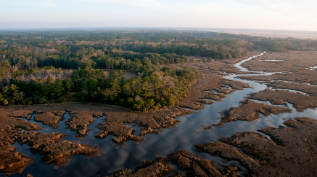Mission Engagement with the “Other 95 Percent”

Editor’s Note: This post originally appeared here.
This spring our board reaffirmed its twenty-year commitment to finding investment opportunities for the Foundation’s endowment that dovetail with the Foundation’s mission areas in conservation, arts and collections. Following IRS requirements, we expend, on average, at least 5% of our assets each year on program. But what we do with the other 95% is just as important, beyond trying to ensure that our investment returns keep up with program outflows and inflation.
To this end, last month three of our board members and two staff attended a mission investing conference sponsored by our endowment advisor, Cambridge Associates. I was struck by the overlap between the mission-related investing risk and opportunity themes highlighted at the conference and some of our recent program team meetings. This was particularly evident in our land conservation mission area, where just the week before I had been in a meeting with some of our Lowcountry conservation grantees discussing climate change adaptation strategies.
Where and how we invest relative to the climate challenge could make a big difference over the long term for both our program and endowment. In the investing world, fossil fuels are now seen as risky for long horizon investors, with the potential for “stranded assets” to remain in the ground as we continue the transition to a clean energy economy. We face similar choices and tradeoffs on the land conservation front. How do we target our grantmaking dollars to support ecosystem resiliency efforts that facilitate adaptation to a rapidly changing environment?
Another connection can be drawn in the area of water resources. Some forward-looking investors are predicting that water will soon be seen as the most valuable commodity on the planet, partly as a result of climate change. How can land conservation ratchet up its protection of watersheds while creating win/win investing opportunities? And what are the technologies that we might invest to better steward our precious water resources on an increasingly thirsty planet.
We can also look at demographic trends for opportunities and risks on both the program and investment sides. Urbanization, in general, and the increasing preference of the younger generation for city-living over the suburbs has been well documented. Supporting the creation of vibrant communities with a lower energy use footprint and that are supportive of a rich artistic fabric could have a big payoff both on the program side and the real estate investments in our endowment.
All this points to an increasing alignment between our programmatic and investment strategies. It’s exciting to witness the cross-fertilization occurring among our board and staff members with various backgrounds, areas of expertise and responsibilities. With help from our advisors and grantees, we will continue to explore how we can maximize strategic deployment of the Foundation’s resources to support healthy ecosystems and sustainable, vibrant communities.
